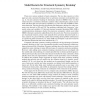Free Online Productivity Tools
i2Speak
i2Symbol
i2OCR
iTex2Img
iWeb2Print
iWeb2Shot
i2Type
iPdf2Split
iPdf2Merge
i2Bopomofo
i2Arabic
i2Style
i2Image
i2PDF
iLatex2Rtf
Sci2ools
112
Voted
CP
2008
Springer
2008
Springer
Model Restarts for Structural Symmetry Breaking
ctural abstractions that were introduced in [17]. Compared with other symmetry-breaking techniques, the big advantage of dynamic symmetry breaking is that it can accommodate dynamic search orderings without running an increased risk of thrashing. Dynamic orderings have often been shown to vastly outperform static orderings in many different types of constraint satisfaction problems. However, when adding static symmetry-breaking constraints that are not aligned with the variable and value orderings, it is entirely possible that we dismiss perfectly good solutions just because they are not the ones that are favored by the static constraints, which (ideally) leave only one representative solution in each equivalence class of solutions. To address this problem, Puget suggested an elegant semi-static symmetry breaking method that provably does not remove the first solution found by a dynamic searchmethod [12]. It is not clear how this method can be generalized, though, and for the case of p...
Artificial Intelligence | CP 2008 | Static Symmetry | Static Symmetry-breaking Constraints | Symmetry Breaking |
Related Content
| Added | 18 Oct 2010 |
| Updated | 18 Oct 2010 |
| Type | Conference |
| Year | 2008 |
| Where | CP |
| Authors | Daniel S. Heller, Aurojit Panda, Meinolf Sellmann, Justin Yip |
Comments (0)

